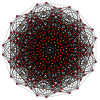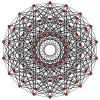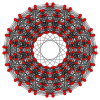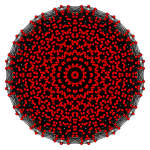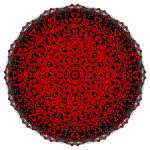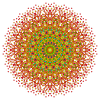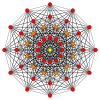Uniform 8-polytope
In eight-dimensional geometry, an eight-dimensional polytope or 8-polytope is a polytope contained by 7-polytope facets. Each 6-polytope ridge being shared by exactly two 7-polytope facets.
A uniform 8-polytope is one which is vertex-transitive, and constructed from uniform 7-polytope facets.
Regular 8-polytopes
[edit]Regular 8-polytopes can be represented by the Schläfli symbol {p,q,r,s,t,u,v}, with v {p,q,r,s,t,u} 7-polytope facets around each peak.
There are exactly three such convex regular 8-polytopes:
- {3,3,3,3,3,3,3} - 8-simplex
- {4,3,3,3,3,3,3} - 8-cube
- {3,3,3,3,3,3,4} - 8-orthoplex
There are no nonconvex regular 8-polytopes.
Characteristics
[edit]The topology of any given 8-polytope is defined by its Betti numbers and torsion coefficients.[1]
The value of the Euler characteristic used to characterise polyhedra does not generalize usefully to higher dimensions, and is zero for all 8-polytopes, whatever their underlying topology. This inadequacy of the Euler characteristic to reliably distinguish between different topologies in higher dimensions led to the discovery of the more sophisticated Betti numbers.[1]
Similarly, the notion of orientability of a polyhedron is insufficient to characterise the surface twistings of toroidal polytopes, and this led to the use of torsion coefficients.[1]
Uniform 8-polytopes by fundamental Coxeter groups
[edit]Uniform 8-polytopes with reflective symmetry can be generated by these four Coxeter groups, represented by permutations of rings of the Coxeter-Dynkin diagrams:
| # | Coxeter group | Forms | ||
|---|---|---|---|---|
| 1 | A8 | [37] | 135 | |
| 2 | BC8 | [4,36] | 255 | |
| 3 | D8 | [35,1,1] | 191 (64 unique) | |
| 4 | E8 | [34,2,1] | 255 | |
Selected regular and uniform 8-polytopes from each family include:
- Simplex family: A8 [37] -















- 135 uniform 8-polytopes as permutations of rings in the group diagram, including one regular:
- {37} - 8-simplex or ennea-9-tope or enneazetton -















- {37} - 8-simplex or ennea-9-tope or enneazetton -
- 135 uniform 8-polytopes as permutations of rings in the group diagram, including one regular:
- Hypercube/orthoplex family: B8 [4,36] -















- 255 uniform 8-polytopes as permutations of rings in the group diagram, including two regular ones:
- {4,36} - 8-cube or octeract-















- {36,4} - 8-orthoplex or octacross -















- {4,36} - 8-cube or octeract-
- 255 uniform 8-polytopes as permutations of rings in the group diagram, including two regular ones:
- Demihypercube D8 family: [35,1,1] -













- 191 uniform 8-polytopes as permutations of rings in the group diagram, including:
- {3,35,1} - 8-demicube or demiocteract, 151 -












 ; also as h{4,36}
; also as h{4,36} 













 .
. - {3,3,3,3,3,31,1} - 8-orthoplex, 511 -













- {3,35,1} - 8-demicube or demiocteract, 151 -
- 191 uniform 8-polytopes as permutations of rings in the group diagram, including:
- E-polytope family E8 family: [34,1,1] -













- 255 uniform 8-polytopes as permutations of rings in the group diagram, including:
- {3,3,3,3,32,1} - Thorold Gosset's semiregular 421,













- {3,34,2} - the uniform 142,












 ,
, - {3,3,34,1} - the uniform 241,













- {3,3,3,3,32,1} - Thorold Gosset's semiregular 421,
- 255 uniform 8-polytopes as permutations of rings in the group diagram, including:
Uniform prismatic forms
[edit]There are many uniform prismatic families, including:
| Uniform 8-polytope prism families | |||||||||||
|---|---|---|---|---|---|---|---|---|---|---|---|
| # | Coxeter group | Coxeter-Dynkin diagram | |||||||||
| 7+1 | |||||||||||
| 1 | A7A1 | [3,3,3,3,3,3]×[ ] | |||||||||
| 2 | B7A1 | [4,3,3,3,3,3]×[ ] | |||||||||
| 3 | D7A1 | [34,1,1]×[ ] | |||||||||
| 4 | E7A1 | [33,2,1]×[ ] | |||||||||
| 6+2 | |||||||||||
| 1 | A6I2(p) | [3,3,3,3,3]×[p] | |||||||||
| 2 | B6I2(p) | [4,3,3,3,3]×[p] | |||||||||
| 3 | D6I2(p) | [33,1,1]×[p] | |||||||||
| 4 | E6I2(p) | [3,3,3,3,3]×[p] | |||||||||
| 6+1+1 | |||||||||||
| 1 | A6A1A1 | [3,3,3,3,3]×[ ]x[ ] | |||||||||
| 2 | B6A1A1 | [4,3,3,3,3]×[ ]x[ ] | |||||||||
| 3 | D6A1A1 | [33,1,1]×[ ]x[ ] | |||||||||
| 4 | E6A1A1 | [3,3,3,3,3]×[ ]x[ ] | |||||||||
| 5+3 | |||||||||||
| 1 | A5A3 | [34]×[3,3] | |||||||||
| 2 | B5A3 | [4,33]×[3,3] | |||||||||
| 3 | D5A3 | [32,1,1]×[3,3] | |||||||||
| 4 | A5B3 | [34]×[4,3] | |||||||||
| 5 | B5B3 | [4,33]×[4,3] | |||||||||
| 6 | D5B3 | [32,1,1]×[4,3] | |||||||||
| 7 | A5H3 | [34]×[5,3] | |||||||||
| 8 | B5H3 | [4,33]×[5,3] | |||||||||
| 9 | D5H3 | [32,1,1]×[5,3] | |||||||||
| 5+2+1 | |||||||||||
| 1 | A5I2(p)A1 | [3,3,3]×[p]×[ ] | |||||||||
| 2 | B5I2(p)A1 | [4,3,3]×[p]×[ ] | |||||||||
| 3 | D5I2(p)A1 | [32,1,1]×[p]×[ ] | |||||||||
| 5+1+1+1 | |||||||||||
| 1 | A5A1A1A1 | [3,3,3]×[ ]×[ ]×[ ] | |||||||||
| 2 | B5A1A1A1 | [4,3,3]×[ ]×[ ]×[ ] | |||||||||
| 3 | D5A1A1A1 | [32,1,1]×[ ]×[ ]×[ ] | |||||||||
| 4+4 | |||||||||||
| 1 | A4A4 | [3,3,3]×[3,3,3] | |||||||||
| 2 | B4A4 | [4,3,3]×[3,3,3] | |||||||||
| 3 | D4A4 | [31,1,1]×[3,3,3] | |||||||||
| 4 | F4A4 | [3,4,3]×[3,3,3] | |||||||||
| 5 | H4A4 | [5,3,3]×[3,3,3] | |||||||||
| 6 | B4B4 | [4,3,3]×[4,3,3] | |||||||||
| 7 | D4B4 | [31,1,1]×[4,3,3] | |||||||||
| 8 | F4B4 | [3,4,3]×[4,3,3] | |||||||||
| 9 | H4B4 | [5,3,3]×[4,3,3] | |||||||||
| 10 | D4D4 | [31,1,1]×[31,1,1] | |||||||||
| 11 | F4D4 | [3,4,3]×[31,1,1] | |||||||||
| 12 | H4D4 | [5,3,3]×[31,1,1] | |||||||||
| 13 | F4×F4 | [3,4,3]×[3,4,3] | |||||||||
| 14 | H4×F4 | [5,3,3]×[3,4,3] | |||||||||
| 15 | H4H4 | [5,3,3]×[5,3,3] | |||||||||
| 4+3+1 | |||||||||||
| 1 | A4A3A1 | [3,3,3]×[3,3]×[ ] | |||||||||
| 2 | A4B3A1 | [3,3,3]×[4,3]×[ ] | |||||||||
| 3 | A4H3A1 | [3,3,3]×[5,3]×[ ] | |||||||||
| 4 | B4A3A1 | [4,3,3]×[3,3]×[ ] | |||||||||
| 5 | B4B3A1 | [4,3,3]×[4,3]×[ ] | |||||||||
| 6 | B4H3A1 | [4,3,3]×[5,3]×[ ] | |||||||||
| 7 | H4A3A1 | [5,3,3]×[3,3]×[ ] | |||||||||
| 8 | H4B3A1 | [5,3,3]×[4,3]×[ ] | |||||||||
| 9 | H4H3A1 | [5,3,3]×[5,3]×[ ] | |||||||||
| 10 | F4A3A1 | [3,4,3]×[3,3]×[ ] | |||||||||
| 11 | F4B3A1 | [3,4,3]×[4,3]×[ ] | |||||||||
| 12 | F4H3A1 | [3,4,3]×[5,3]×[ ] | |||||||||
| 13 | D4A3A1 | [31,1,1]×[3,3]×[ ] | |||||||||
| 14 | D4B3A1 | [31,1,1]×[4,3]×[ ] | |||||||||
| 15 | D4H3A1 | [31,1,1]×[5,3]×[ ] | |||||||||
| 4+2+2 | |||||||||||
| ... | |||||||||||
| 4+2+1+1 | |||||||||||
| ... | |||||||||||
| 4+1+1+1+1 | |||||||||||
| ... | |||||||||||
| 3+3+2 | |||||||||||
| 1 | A3A3I2(p) | [3,3]×[3,3]×[p] | |||||||||
| 2 | B3A3I2(p) | [4,3]×[3,3]×[p] | |||||||||
| 3 | H3A3I2(p) | [5,3]×[3,3]×[p] | |||||||||
| 4 | B3B3I2(p) | [4,3]×[4,3]×[p] | |||||||||
| 5 | H3B3I2(p) | [5,3]×[4,3]×[p] | |||||||||
| 6 | H3H3I2(p) | [5,3]×[5,3]×[p] | |||||||||
| 3+3+1+1 | |||||||||||
| 1 | A32A12 | [3,3]×[3,3]×[ ]×[ ] | |||||||||
| 2 | B3A3A12 | [4,3]×[3,3]×[ ]×[ ] | |||||||||
| 3 | H3A3A12 | [5,3]×[3,3]×[ ]×[ ] | |||||||||
| 4 | B3B3A12 | [4,3]×[4,3]×[ ]×[ ] | |||||||||
| 5 | H3B3A12 | [5,3]×[4,3]×[ ]×[ ] | |||||||||
| 6 | H3H3A12 | [5,3]×[5,3]×[ ]×[ ] | |||||||||
| 3+2+2+1 | |||||||||||
| 1 | A3I2(p)I2(q)A1 | [3,3]×[p]×[q]×[ ] | |||||||||
| 2 | B3I2(p)I2(q)A1 | [4,3]×[p]×[q]×[ ] | |||||||||
| 3 | H3I2(p)I2(q)A1 | [5,3]×[p]×[q]×[ ] | |||||||||
| 3+2+1+1+1 | |||||||||||
| 1 | A3I2(p)A13 | [3,3]×[p]×[ ]x[ ]×[ ] | |||||||||
| 2 | B3I2(p)A13 | [4,3]×[p]×[ ]x[ ]×[ ] | |||||||||
| 3 | H3I2(p)A13 | [5,3]×[p]×[ ]x[ ]×[ ] | |||||||||
| 3+1+1+1+1+1 | |||||||||||
| 1 | A3A15 | [3,3]×[ ]x[ ]×[ ]x[ ]×[ ] | |||||||||
| 2 | B3A15 | [4,3]×[ ]x[ ]×[ ]x[ ]×[ ] | |||||||||
| 3 | H3A15 | [5,3]×[ ]x[ ]×[ ]x[ ]×[ ] | |||||||||
| 2+2+2+2 | |||||||||||
| 1 | I2(p)I2(q)I2(r)I2(s) | [p]×[q]×[r]×[s] | |||||||||
| 2+2+2+1+1 | |||||||||||
| 1 | I2(p)I2(q)I2(r)A12 | [p]×[q]×[r]×[ ]×[ ] | |||||||||
| 2+2+1+1+1+1 | |||||||||||
| 2 | I2(p)I2(q)A14 | [p]×[q]×[ ]×[ ]×[ ]×[ ] | |||||||||
| 2+1+1+1+1+1+1 | |||||||||||
| 1 | I2(p)A16 | [p]×[ ]×[ ]×[ ]×[ ]×[ ]×[ ] | |||||||||
| 1+1+1+1+1+1+1+1 | |||||||||||
| 1 | A18 | [ ]×[ ]×[ ]×[ ]×[ ]×[ ]×[ ]×[ ] | |||||||||
The A8 family
[edit]The A8 family has symmetry of order 362880 (9 factorial).
There are 135 forms based on all permutations of the Coxeter-Dynkin diagrams with one or more rings. (128+8-1 cases) These are all enumerated below. Bowers-style acronym names are given in parentheses for cross-referencing.
See also a list of 8-simplex polytopes for symmetric Coxeter plane graphs of these polytopes.
| A8 uniform polytopes | ||||||||||||
|---|---|---|---|---|---|---|---|---|---|---|---|---|
| # | Coxeter-Dynkin diagram | Truncation indices | Johnson name | Basepoint | Element counts | |||||||
| 7 | 6 | 5 | 4 | 3 | 2 | 1 | 0 | |||||
| 1 |
| t0 | 8-simplex (ene) | (0,0,0,0,0,0,0,0,1) | 9 | 36 | 84 | 126 | 126 | 84 | 36 | 9 |
| 2 |
| t1 | Rectified 8-simplex (rene) | (0,0,0,0,0,0,0,1,1) | 18 | 108 | 336 | 630 | 576 | 588 | 252 | 36 |
| 3 |
| t2 | Birectified 8-simplex (bene) | (0,0,0,0,0,0,1,1,1) | 18 | 144 | 588 | 1386 | 2016 | 1764 | 756 | 84 |
| 4 |
| t3 | Trirectified 8-simplex (trene) | (0,0,0,0,0,1,1,1,1) | 1260 | 126 | ||||||
| 5 |
| t0,1 | Truncated 8-simplex (tene) | (0,0,0,0,0,0,0,1,2) | 288 | 72 | ||||||
| 6 |
| t0,2 | Cantellated 8-simplex | (0,0,0,0,0,0,1,1,2) | 1764 | 252 | ||||||
| 7 |
| t1,2 | Bitruncated 8-simplex | (0,0,0,0,0,0,1,2,2) | 1008 | 252 | ||||||
| 8 |
| t0,3 | Runcinated 8-simplex | (0,0,0,0,0,1,1,1,2) | 4536 | 504 | ||||||
| 9 |
| t1,3 | Bicantellated 8-simplex | (0,0,0,0,0,1,1,2,2) | 5292 | 756 | ||||||
| 10 |
| t2,3 | Tritruncated 8-simplex | (0,0,0,0,0,1,2,2,2) | 2016 | 504 | ||||||
| 11 |
| t0,4 | Stericated 8-simplex | (0,0,0,0,1,1,1,1,2) | 6300 | 630 | ||||||
| 12 |
| t1,4 | Biruncinated 8-simplex | (0,0,0,0,1,1,1,2,2) | 11340 | 1260 | ||||||
| 13 |
| t2,4 | Tricantellated 8-simplex | (0,0,0,0,1,1,2,2,2) | 8820 | 1260 | ||||||
| 14 |
| t3,4 | Quadritruncated 8-simplex | (0,0,0,0,1,2,2,2,2) | 2520 | 630 | ||||||
| 15 |
| t0,5 | Pentellated 8-simplex | (0,0,0,1,1,1,1,1,2) | 5040 | 504 | ||||||
| 16 |
| t1,5 | Bistericated 8-simplex | (0,0,0,1,1,1,1,2,2) | 12600 | 1260 | ||||||
| 17 |
| t2,5 | Triruncinated 8-simplex | (0,0,0,1,1,1,2,2,2) | 15120 | 1680 | ||||||
| 18 |
| t0,6 | Hexicated 8-simplex | (0,0,1,1,1,1,1,1,2) | 2268 | 252 | ||||||
| 19 |
| t1,6 | Bipentellated 8-simplex | (0,0,1,1,1,1,1,2,2) | 7560 | 756 | ||||||
| 20 |
| t0,7 | Heptellated 8-simplex | (0,1,1,1,1,1,1,1,2) | 504 | 72 | ||||||
| 21 |
| t0,1,2 | Cantitruncated 8-simplex | (0,0,0,0,0,0,1,2,3) | 2016 | 504 | ||||||
| 22 |
| t0,1,3 | Runcitruncated 8-simplex | (0,0,0,0,0,1,1,2,3) | 9828 | 1512 | ||||||
| 23 |
| t0,2,3 | Runcicantellated 8-simplex | (0,0,0,0,0,1,2,2,3) | 6804 | 1512 | ||||||
| 24 |
| t1,2,3 | Bicantitruncated 8-simplex | (0,0,0,0,0,1,2,3,3) | 6048 | 1512 | ||||||
| 25 |
| t0,1,4 | Steritruncated 8-simplex | (0,0,0,0,1,1,1,2,3) | 20160 | 2520 | ||||||
| 26 |
| t0,2,4 | Stericantellated 8-simplex | (0,0,0,0,1,1,2,2,3) | 26460 | 3780 | ||||||
| 27 |
| t1,2,4 | Biruncitruncated 8-simplex | (0,0,0,0,1,1,2,3,3) | 22680 | 3780 | ||||||
| 28 |
| t0,3,4 | Steriruncinated 8-simplex | (0,0,0,0,1,2,2,2,3) | 12600 | 2520 | ||||||
| 29 |
| t1,3,4 | Biruncicantellated 8-simplex | (0,0,0,0,1,2,2,3,3) | 18900 | 3780 | ||||||
| 30 |
| t2,3,4 | Tricantitruncated 8-simplex | (0,0,0,0,1,2,3,3,3) | 10080 | 2520 | ||||||
| 31 |
| t0,1,5 | Pentitruncated 8-simplex | (0,0,0,1,1,1,1,2,3) | 21420 | 2520 | ||||||
| 32 |
| t0,2,5 | Penticantellated 8-simplex | (0,0,0,1,1,1,2,2,3) | 42840 | 5040 | ||||||
| 33 |
| t1,2,5 | Bisteritruncated 8-simplex | (0,0,0,1,1,1,2,3,3) | 35280 | 5040 | ||||||
| 34 |
| t0,3,5 | Pentiruncinated 8-simplex | (0,0,0,1,1,2,2,2,3) | 37800 | 5040 | ||||||
| 35 |
| t1,3,5 | Bistericantellated 8-simplex | (0,0,0,1,1,2,2,3,3) | 52920 | 7560 | ||||||
| 36 |
| t2,3,5 | Triruncitruncated 8-simplex | (0,0,0,1,1,2,3,3,3) | 27720 | 5040 | ||||||
| 37 |
| t0,4,5 | Pentistericated 8-simplex | (0,0,0,1,2,2,2,2,3) | 13860 | 2520 | ||||||
| 38 |
| t1,4,5 | Bisteriruncinated 8-simplex | (0,0,0,1,2,2,2,3,3) | 30240 | 5040 | ||||||
| 39 |
| |||||||||||


 French
French Deutsch
Deutsch





